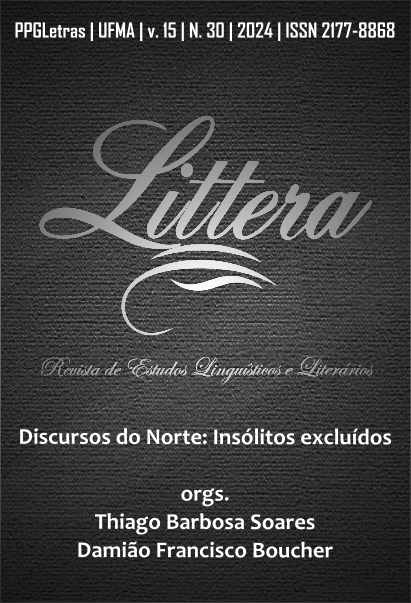MUÃ, KA’A IARY E KA'A: lendas etiológicas de resgate da identidade indígena paraguaia
DOI:
https://doi.org/10.18764/2177-8868v15n30.2024.19Palabras clave:
Narrativas etiológicas, Literatura indígena paraguaia, Mito, Muã, Ka’a Iary e Ka’aResumen
Durante os séculos em que a América do Norte, Sul e Central estiveram sob o domínio dos europeus, como Espanha e Portugal, as etnias originárias, e tudo o que as envolvem, estiveram subjugadas, dominadas pelos povos europeus. contudo, o Império espanhol não conseguiu suplantar completamente os Impérios Inca, Maia e Asteca, que resistiram às intempéries do tempo, da dominação, da miscigenação inevitável. Seus saberes permaneceram, principalmente os que resgatam e memorizam as relações desses povos com a natureza, dessa forma, as narrativas etiológicas, isto é, as lendas, mitos e relatos dos povos originários que mostram as causas, motivos, razões, fundamentos, e bases da existência de algum elemento de suas culturas, servem como documentação oral que nos atestam e justificam a existência de qualquer elemento antropocultural ou natural. Dito isso, nos propomos a mostrar como, nas lendas etiológicas paraguaias (argentinas/brasileiras) Muã, Ka'a e Ka’a Iary, explicam a existência do politeísmo/sincretismo religioso (Caipora, Tupã), os elementos da fauna (vagalume), da flora (erva mate) e de aspectos antropoculturais dos povos originários com os Guaranis que habitavam essas bandas de cá. Para desenvolver nossa pesquisa de cunho bibliográfica e qualitativa, fundamentamo-la nos estudos de
Montesino (2019), Campbell (1949, 1991), Eliade (1972), Bayard (2002), Thompson (1992), entre outros que tratam das literaturas dos Povos originários da América Latina. Os resultados preliminares obtidos a partir da análise dos elementos etiológicos das referidas lendas, nos mostram que a cosmovisão das etnias originárias era distinta da nossa, pois além de serem profundos conhecedores da natureza, a respeitavam, pois se achavam como parte integrante dela.
Descargas
Citas
BAYARD, Jean- Pierre. História das lendas. SP: Book e BooksBrasil.com, 2002.
CAMPBELL, Joseph. O poder do mito. [s.l.]: Editora Palas Athena, 1991.
_____. O herói de mil faces. Tradução: Adail Ubirajara Sobral. São Paulo: Editora Pensamento, 1949.
ELIADE, Mircea. Mito e Realidade. Tradução: Pola Civelli. São Paulo: Editora Perspectiva, 1972.
MONTESINO, Jorge. Leyendas y Creencias populares del Paraguay. [s.l.]: Servi Libro, 2019.
Mitos Estiológicos. Enciclopedia de Ejemplos, 2015. Disponível em: <https://www.ejemplos.co/mitos-etiologicos/>. Acesso em: 24 de fev. de 2024.
THOMPSON, Paul. A voz do passado: história oral. Trad.: Lólio Lourenço de Oliveira. Rio de Janeiro: Paz e Terra, 1992.
Descargas
Publicado
Versiones
- 2024-12-31 (2)
- 2024-12-26 (1)
Cómo citar
Número
Sección
Licencia

Esta obra está bajo una licencia internacional Creative Commons Atribución-NoComercial-SinDerivadas 4.0.
Direitos autorais Littera on line
Este obra está licenciado com uma Licença Creative Commons Atribuição-NãoComercial-SemDerivações 4.0 Internacional.









